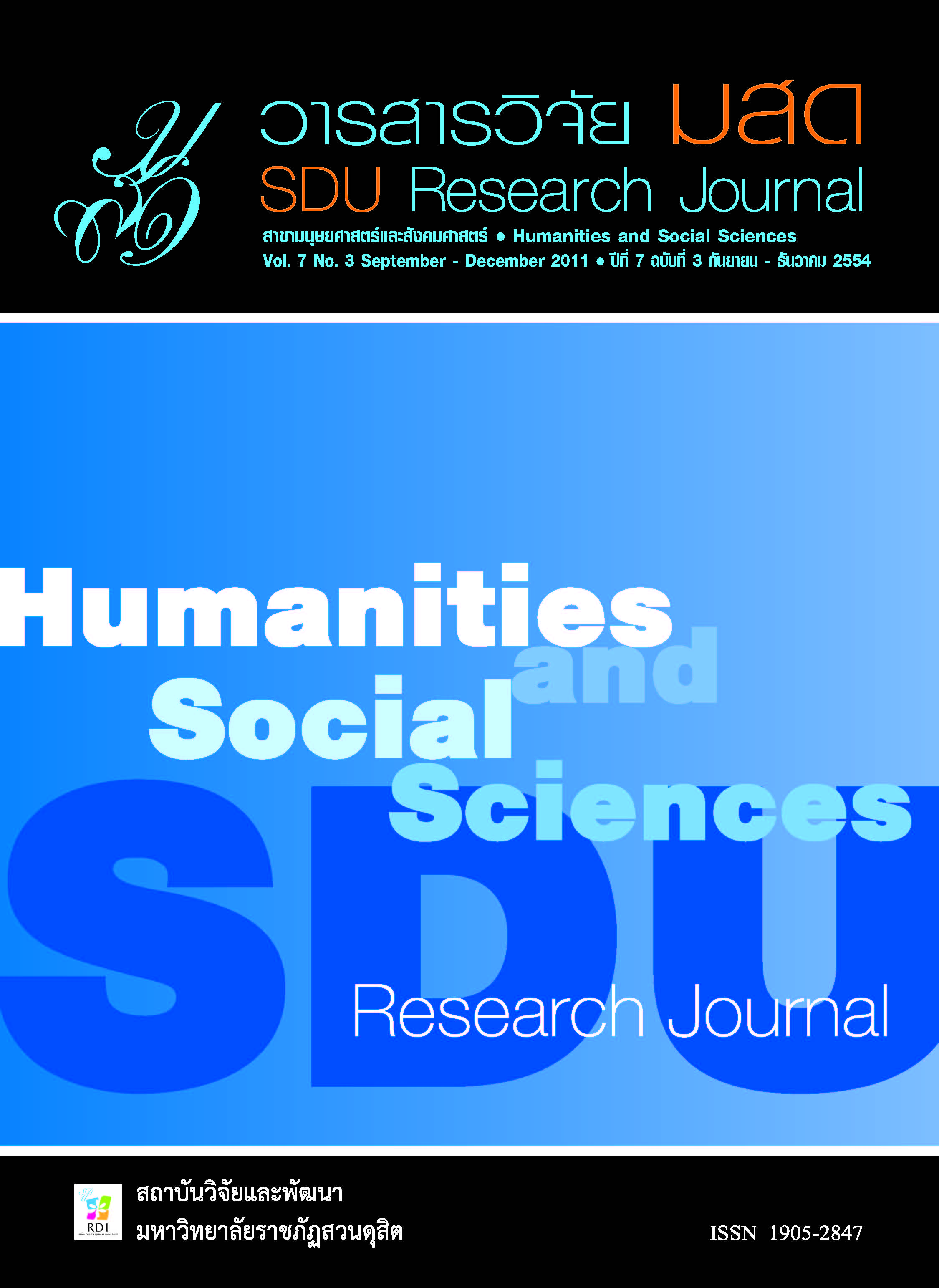รายงานการประเมินผล หลักสูตรพยาบาลศาสตรบัณฑิต พ.ศ. 2550
Keywords:
การประเมินผลหลักสูตร, หลักสูตรพยาบาลศาสตรบัณฑิต, Curriculum evaluation, program evaluation, the Bachelor of Nursing Science ProgramAbstract
บทคัดย่อ
การวิจัยครั้งนี้ เป็นการวิจัยประเมินผลหลักสูตรพยาบาลศาสตรบัณฑิต พ.ศ. 2550 ของมหาวิทยาลัยราชภัฏสวนดุสิต ที่ใช้ระเบียบวิธีวิจัยเชิงพรรณนา ทำการศึกษาภายหลังการใช้หลักสูตร ตั้งแต่ปีการศึกษา 2550 จนสิ้นสุดภาคเรียนที่ 1 ปีการศึกษา 2552 เป็นการศึกษาจากประชากร คือ อาจารย์และนักศึกษาทุกคน การประเมินใช้แบบจำลองซิปป์ ของของสตัฟเฟิลบีม (CIPP Model) ทุกองค์ประกอบของหลักสูตร ตั้งแต่บริบท ปัจจัยนำเข้าและกระบวนการนำหลักสูตรไปใช้ ยกเว้น ผลผลิตของหลักสูตร เนื่องจากยังไม่มีผู้สำเร็จการศึกษา ผลการวิจัย สรุปได้ดังนี้
ในด้านบริบทโดยการประเมินความเหมาะสมของปรัชญา วัตถุประสงค์ โครงสร้าง และเนื้อหาสาระของหลักสูตรพบว่า อาจารย์คณะพยาบาลศาสตร์มีความคิดเห็นว่าวัตถุประสงค์ของหลักสูตร 1) มีความสอดคล้องกับปรัชญาของหลักสูตร 2) มีความคลอบคลุมด้านพุทธิพิสัย จิตพิสัยและทักษะพิสัย 3) มีความสอดคล้องกับสภาพปัญหาความต้องการของสังคมและตลาดแรงงาน 4) มีความสอดคล้องกับสภาพความต้องการทางวิชาการและวิชาชีพ และ 5) มีการกำหนดคุณลักษณะบัณฑิตผู้จบหลักสูตรไว้ชัดเจน โดยมีคะแนนเฉลี่ย ตั้งแต่ 4.27 - 5.00 ซึ่งเมื่อเปรียบเทียบกับเกณฑ์ประเมินที่ตั้งไว้ จัดว่าอยู่ในระดับมากถึงมากที่สุด ส่วนผลการประเมินโครงสร้างและเนื้อหาสาระของหลักสูตรในด้าน 1) ความชัดเจนของวัตถุประสงค์ 2) ความสำคัญและเป็นประโยชน์ 3) ความทันสมัยของเนื้อหาวิชา และ4) ความเหมาะสมของวัตถุประสงค์และวิธีจัดการเรียนการสอนของแต่ละวิชา ตามความคิดเห็นของนักศึกษา มีคะแนนเฉลี่ยอยู่ระหว่าง 4.14 - 5.00 ซึ่งเมื่อเปรียบเทียบกับเกณฑ์ประเมินที่ตั้งไว้ จัดว่าอยู่ในระดับมาก ถึงมากที่สุด
การประเมินปัจจัยนำเข้า พบว่า จำนวน ประสบการณ์ของอาจารย์และอัตราส่วนของอาจารย์ต่อนักศึกษาเป็นไปตามเกณฑ์มาตรฐาน แต่สัดส่วนอาจารย์ระดับปริญญาเอก : อาจารย์ระดับปริญญาโท ยังไม่เป็นไปตามเกณฑ์มาตรฐานของสภาการพยาบาล ด้านแรงจูงใจในการเลือกเรียนพยาบาลนักศึกษาเห็นว่าวิชาชีพการพยาบาลนั้นมีคุณค่าต่อตนเอง ครอบครัว และต่อสังคมและประเทศชาติ สำหรับการประเมินความคิดเห็นของนักศึกษาต่อตำราในห้องสมุดพบว่า นักศึกษาส่วนใหญ่เห็นว่าตำราในห้องสมุดมีความทันสมัยและเพียงพอ ส่วนการประเมินความพร้อมด้านโสตทัศนูปกรณ์ อุปกรณ์การศึกษา อาคารสถานที่เรียน และแหล่งฝึกภาคปฏิบัติ นักศึกษาส่วนใหญ่ ร้อยละ 73 ขึ้นไปเห็นว่าปัจจัยสนับสนุนการจัดการเรียนการสอนที่มหาวิทยาลัยจัดให้ มีความทันสมัย ส่วนด้านความเพียงพอ นักศึกษาเห็นว่าอุปกรณ์สนับสนุนการศึกษาที่มีจำนวนไม่เพียงพอมากที่สุด คือ คอมพิวเตอร์ คิดเป็นร้อยละ 48.08 ทั้งนี้เนื่องจากขณะที่ทำการเก็บข้อมูล นักศึกษาชั้นปีที่ 1 ยังไม่ได้รับแจกคอมพิวเตอร์โน้ตบุค จากทางมหาวิทยาลัย สำหรับด้าน อาคารสถานที่เรียน ที่นักศึกษาเห็นว่ามีจำนวนไม่เพียงพอ สูงสุด คือ ห้องฝึกปฏิบัติการทางพยาบาล และห้องประชุม กลุ่มย่อย คิดเป็น ร้อยละ 30.77 เท่ากัน
การประเมินกระบวนการจัดการเรียนการสอนทั้งภาคทฤษฎีและภาคปฏิบัติตามความเห็นของนักศึกษาและ อาจารย์ ในประเด็นแรก คือ การประเมินการออกแบบการเรียนการสอนรายวิชาที่รับผิดชอบโดยอาจารย์คณะพยาบาลศาสตร์ พบว่า ส่วนใหญ่มีการกำหนดจุดประสงค์ วิธีการสอน การประเมินผลเหมาะสม มีการระบุตำราหลัก และหนังสืออ้างอิง ที่ทันสมัย มีการนำผลวิจัยมาใช้ และมีการนำเทคโนโลยีสารสนเทศมาใช้ในการเรียนการสอน แต่มีการทำวิจัยในชั้น เรียนควบคู่ไปด้วย และมีการพัฒนาสื่อ/นวัตกรรมการเรียนการสอนน้อย และยังไม่มีรายวิชาใดมีการบูรณาการกับการ บริการวิชาการ/ทำนุบำรุงศิลปวัฒนธรรม ประเด็นที่สอง การประเมินประสิทธิภาพการเรียนการสอนทั้งภาคทฤษฎีและ ภาคปฏิบัติโดยนักศึกษา พบว่า นักศึกษาประเมินการสอนของอาจารย์พยาบาลอยู่ในระดับดีมาก (ค่าเฉลี่ย 4.5 ขึ้นไป) ทุกคน และประเมินการสอนของอาจารย์จากคณะอื่นๆ และจากภายนอกอยู่ในระดับดี ถึงดีมาก (ค่าเฉลี่ย 4.0 ขึ้นไป) ประเด็นที่สาม การประเมินประสิทธิภาพการเรียนการสอนทั้งภาคทฤษฎีและภาคปฏิบัติโดยคณะกรรมการพัฒนา ประสิทธิภาพการจัดการเรียนการสอน พบว่า อาจารย์ที่ได้รับการประเมินมีประสิทธิภาพการสอนอยู่ในระดับดีขึ้นไป ทุกข้อ และประเด็นที่สี่ การประเมินการจัดการเรียนการสอนรายวิชา ทั้งภาคทฤษฎีและภาคปฏิบัติ พบว่า รายวิชา ในชั้นปีที่ 2 และ 3 ซึ่งเป็นวิชาในหมวดพื้นฐานวิชาชีพและวิชาชีพ ได้รับการประเมินอยู่ในระดับดีมาก (ค่าเฉลี่ย 4.5 ขึ้นไป) ทุกวิชาและวิชาในชั้นปีที่ 1 ซึ่งส่วนใหญ่เป็นหมวดการศึกษาทั่วไปและพื้นฐานวิชาชีพ ได้รับการประเมินอยู่ใน ระดับดีถึงดีมาก (ค่าเฉลี่ย 4.0 ขึ้นไป)
คำสำคัญ : การประเมินผลหลักสูตร, หลักสูตรพยาบาลศาสตรบัณฑิต
Abstract
This research evaluated Suan Dusit Rajabhat University’s Bachelor of Nursing Science Program B.E. 2550 from the 2007 academic year to the first semester of the 2009 academic year. It was conducted using Stufflebeam’s CIPP model and incorporated instructors and students as part of the sample group. The evaluation included the context, input and process of the program but not its output because there were no graduates of the program yet.
The results of the study are summarized as follows:
In terms of the context, the appropriateness of the program’s philosophy, objectives, structure and main contents were evaluated by the instructors of the faculty, whose opinions were that the objectives of the curriculum 1) corresponded with its philosophy; 2) consisted of cognitive, affective and psychomotor learning domains; 3) corresponded with the problems and needs of Thai society and its labor market; 4) corresponded with academic and professional needs and 5) clearly specified the graduates’ characteristics. The average scores ranged from 4.27 to 5.00, which were considered high to very high level compared to the set criteria.
Regarding the evaluation of the structure and the content of the curriculum in terms of 1) the clarity of objectives 2) the importance and benefits 3) the recency of the course and 4) the appropriateness of the objectives and methods of lecturing in each subject as perceived by the students, the average scores ranged from 4.14 - 5.00 which were considered high to very high level, compared with a set criteria. The input evaluation revealed that the numbers and experiences of instructors and the ratio of instructors to students met the standard criteria set by the Thai Nursing Council, but the proportion of instructors who have doctoral degrees and master’s degrees did not meet the criteria. Regarding the motivation to be nursing students, students believed nursing not only builds self worth but also builds value to family, society and the nation.
In terms of educational supporting factors, the students viewed that the amount of textbooks in the library was sufficient and that the textbooks were up to date. The majority of the students, or more than 73% of the respondents, perceived that the audiovisual aids, learning materials, classrooms, and training facilities were up to date. 48.08% of them viewed that personal notebooks provided by the university were not enough since when the data was collected the freshmen were not yet given a personal computer. Regarding building and study rooms, respondents evaluated that they were inadequate. 30.77% of them ranked nursing laboratories and rooms for small group meetings to be the most insufficient.
The process of the theory and practice teaching according to the opinion of the students and faculty was evaluated in four aspects. The first aspect was the evaluation of the design of the course that was undertaken by the Faculty of Nursing. It was found that course designs were appropriate in terms of objectives, teaching and evaluation methods. They also identified main texts. The course designs also included up to date bibliographies and the utilization of research and information technology. However, they still lacked classroom research, instructional media, innovations and the integration of teaching to academic services or art and cultural promotion activities. On the second aspect, the evaluation of instructor’s teaching performance, the students rated the nursing instructors in all theoretical and practice subjects at a very high level (mean ≥ 4.5). Similarly, other faculty’s instructors and academic officers rated high to very high level (mean ≥ 4.0). The third aspect was the evaluation of instructor’s teaching performance by the Instructional Development Committee. It was found that instructors’ teaching performances were at a high level in all items.
As for the evaluation of course management in both theoretical and practical methods, second and third year students rated the management of subjects (which were mostly professional nursing subjects) very high (mean ≥ 4.5), and first year students rated the management of subjects (most of which were general education and professional foundation subjects) high to very high (mean ≥ 4.0).
Keywords : Curriculum evaluation, program evaluation, the Bachelor of Nursing Science Program








